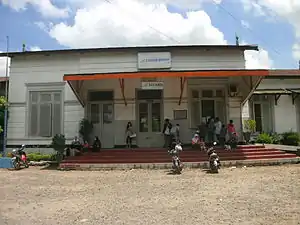Serang railway station
Serang station (Indonesian: stasiun Serang), is a railway station located in Serang, Banten on the Jakarta Kota-Anyer Kidul railway. The station is located to the northeast of the city center.
 Front view of the station (2013) | |
| Location | Jalan Kitapa No. 2, Serang Indonesia |
| Coordinates | 6.1124°S 106.1586°E |
| Elevation | 25.66 m |
| Owned by | PT Kereta Api |
| Line(s) | Jakarta Kota-Anyer Kidul |
| Platforms | 1 side platform, 1 island platform |
| Tracks | 3 |
| Other information | |
| Station code | SG |
| History | |
| Opened | 1900 |
History
Serang railway station was opened on 1 July 1900, together with the completion of the railway stretch between Rangkasbitung and Serang. Serang was a terminal station for several months until 20 December 1900. On that day the line extension to Anyer Kidul was finished, thereby completing the entire Banten railway (Dutch: Bantamlijn).[1]
Building
Given Serang's status as a provincial capital, the station has been a relatively important stop on the Banten railway. This is reflected in the more extensive facilities, such as multiple platforms and tracks. The station actually has four tracks, but the easternmost track is unusable, leaving only three tracks in use.
The front of the station building faces west. The building stands on foundations of up to 60 centimeters from the ground. The station building has two main rooms: one for the train dispatcher and station master, and another for administration and ticket sale. Between these two is the waiting area. Part of the building still retains the original Dutch architecture, such as the tall doors and windows.
Services
- Kalimaya between Merak and Tanah Abang (express)
- Krakatau Ekspres between Merak and Kediri (express)
- Banten Ekspres between Merak and Kampung Bandan (local)
- Patas Merak between Merak and Angke (local)
References
- Teeuwen, D. (2010). "Manpower, steam tractions and contact wires" (PDF).
- Banten Department of Culture and Tourism, Banten Heritage Building (2008). Mengenal Banten 3. Banten: Banten Department of Culture and Tourism. pp. 34–35.